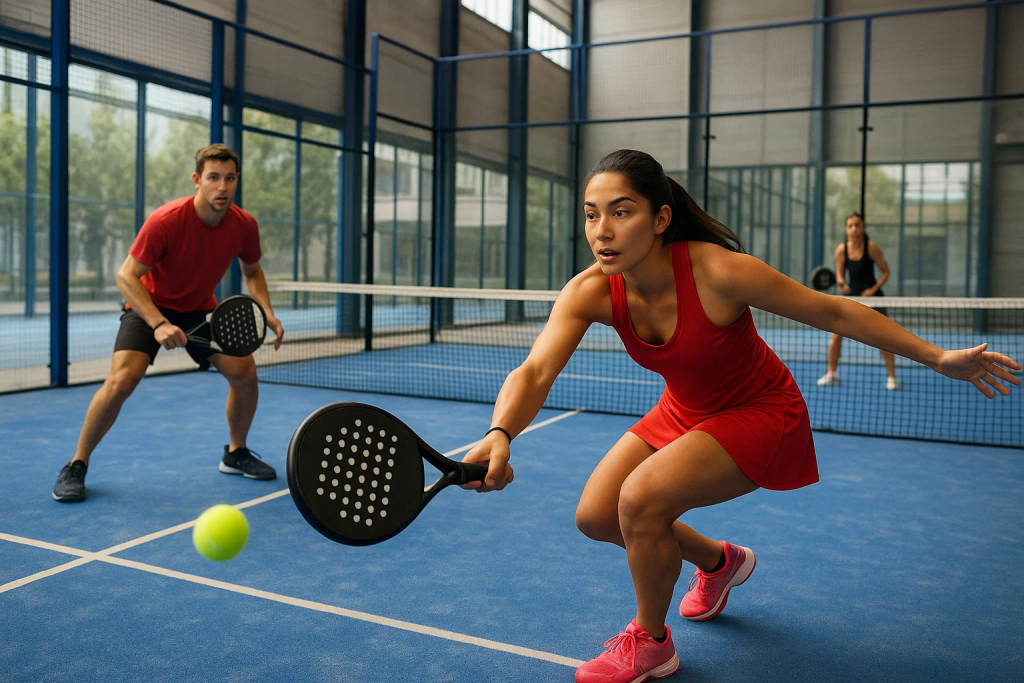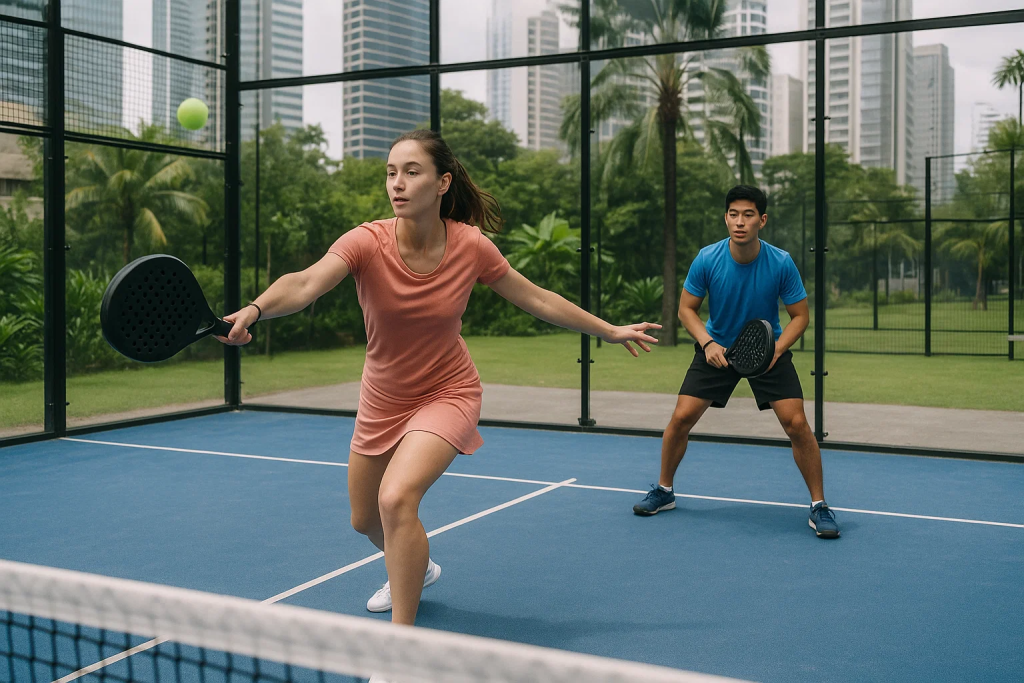Table of Contents
The Rise of Padel in Manila
Padel is a social, accessible, and thrilling sport that anyone can enjoy. Unlike tennis, Padel courts are smaller, the rackets are solid with no strings, and the ball bounces lower, which means games are fast and filled with action. As tennis enthusiasts look for new ways to challenge themselves, Padel offers a fresh alternative that requires less space and is just as competitive and fun.
In recent years, a new sports trend has been spreading globally, and it’s making waves right here in the Philippines. Padel, a sport that combines elements of tennis and squash, has been gaining significant traction in various cities around the world, and Manila is no exception. With its growing popularity in Spain, Argentina, and the UAE, the Philippines is now embracing this exciting, fast-paced sport as an alternative to traditional tennis.

In this article, we will delve into the growing popularity of Padel in Manila, how it compares to tennis, where you can play, and the benefits of playing Padel. Whether you’re new to the sport or looking to explore new opportunities, this guide will provide everything you need to know about Padel and its proximity to tennis in the vibrant sports scene of Manila.
What is Padel? A Brief Overview
Before diving into the growing Padel scene in Manila, let’s take a closer look at the sport itself. Padel is often referred to as a combination of tennis and squash. It is played on a rectangular court that is much smaller than a tennis court, typically 10 meters wide and 20 meters long, with walls that allow the ball to rebound.
Key Differences Between Padel and Tennis:
- Court Size: Padel courts are about one-third the size of tennis courts, which makes the game more accessible to people of all ages and skill levels.
- Equipment: Instead of a traditional tennis racket, Padel players use a solid racket with holes and no strings.
- Ball: The Padel ball is similar to a tennis ball but with less pressure, so it bounces lower.
- Gameplay: Padel is played in doubles (with two teams of two players), and the ball can bounce off the walls, similar to squash, which adds an exciting tactical element to the game.
Unlike tennis, Padel doesn’t require massive space or a high level of skill to get started, making it an ideal sport for beginners while still being competitive enough for advanced players.
Why Padel is Gaining Popularity in Manila
1. A New Sports Trend
As the popularity of tennis continues to grow in the Philippines, Padel offers a fresh alternative that attracts players looking for a faster-paced, social game. The introduction of Padel facilities in Manila has sparked interest from tennis players and fitness enthusiasts who are eager to try a new sport that combines elements of both tennis and squash.
2. Accessibility and Ease of Play
One of the main reasons Padel has become so popular is its accessibility. The smaller court size and the simplified rules make it easier for beginners to get into the game quickly. The fact that Padel is usually played in doubles makes it even more appealing for social gatherings, corporate events, and recreational leagues.
3. Padel as a Social Sport
Padel is not just about competition; it is inherently social. The doubles format makes it a team-based sport, which fosters communication and collaboration. It is perfect for people looking for an interactive sports experience while staying fit. The fact that Padel courts are often located in parks, resorts, and sports clubs in Manila also encourages people to gather and play in a fun, friendly environment.
4. Tennis Enthusiasts Seeking a New Challenge
For tennis players, Padel provides a new challenge without being too drastically different from their sport. While tennis players are used to the basic mechanics of ball striking, Padel introduces new tactical elements thanks to the walls and smaller court. This has led many tennis players to explore Padel as a way to refine their skills while enjoying a fresh and exciting alternative to their usual game.
Where to Play Padel in Manila?
As Padel grows in popularity, Padel courts are starting to appear in more locations across Manila. The capital is quickly becoming a hub for Padel enthusiasts, and several venues now offer dedicated Padel courts for both casual play and competitive events. Here are some of the best places in Manila to experience Padel:
1. Padel Club Manila (Makati)
One of the first dedicated Padel facilities in Manila, Padel Club Manila, is located in Makati. This club offers professional Padel courts, equipment rentals, and the option for both recreational and competitive play. The club also offers beginner lessons and corporate packages, making it a great option for those new to the sport or looking to enhance their skills.
2. Makati Sports Club
The Makati Sports Club recently added Padel courts to its sports facilities, catering to both tennis players and newcomers to the sport. This private club provides Padel lessons, social events, and opportunities to play in a relaxed, yet competitive environment.
3. The Manila Polo Club (Makati)
Another venue in Makati that offers Padel is the prestigious Manila Polo Club. Known for its sports facilities, the club has recently introduced Padel courts for members. Padel is fast becoming a favorite among members of this exclusive sports club.
4. Play Padel Philippines
Located in Bonifacio Global City (BGC), Play Padel Philippines is another notable venue. This club offers high-quality Padel courts, training, and a welcoming atmosphere for people of all skill levels. The club also hosts Padel tournaments and social events, making it an ideal destination for both beginners and seasoned players.

5. Resorts World Manila
Several resorts and luxury hotels in Manila now offer Padel courts as part of their amenities. These venues allow guests to enjoy Padel as part of their leisure activities, offering a combination of relaxation and sport in one destination. Resorts like Resorts World Manila and others in the area are beginning to introduce Padel as part of their diverse sporting offerings.
How to Play Padel: A Beginner’s Guide
If you are considering giving Padel a try, here’s a beginner’s guide to help you get started. The great thing about Padel is that it doesn’t require extensive experience to begin playing.
1. Learn the Basics of Padel
Before stepping onto the court, familiarize yourself with the basic rules:
- Teams: Padel is usually played in doubles, with each team consisting of two players.
- Serve: The serve must be underhand, and the ball must bounce on the ground before hitting the walls.
- Scoring: Padel uses the same scoring system as tennis: 15, 30, 40, and game.
- Walls: Unlike tennis, the ball can bounce off the walls, which adds a unique strategic element to the game.
2. Get the Right Equipment
For Padel, you’ll need a Padel racket, which is solid and perforated, unlike the stringed rackets used in tennis. You’ll also need a Padel ball, which is similar to a tennis ball but with less pressure, making it bounce lower.
3. Start with Basic Drills
Once you’re familiar with the basic rules, start practicing with drills that help improve your positioning, ball control, and basic stroke techniques. Many clubs in Manila offer Padel lessons for beginners, so take advantage of these services to get started.
The Benefits of Padel: Why You Should Try It
1. Improved Cardiovascular Health
Padel provides an excellent cardiovascular workout. The smaller court and fast-paced nature of the game allow players to engage in intense cardio, boosting heart health while having fun.
2. Social Interaction
Since Padel is mostly played in doubles, it encourages social interaction. Whether you’re playing with friends or joining a corporate event, Padel is a great way to meet new people and strengthen relationships.
3. Low Impact on Joints
Compared to tennis, Padel is gentler on the joints due to the smaller court size and lower intensity of the game. It’s a sport that can be enjoyed by people of all ages and fitness levels, with a reduced risk of injury.
4. Mental and Emotional Benefits
The strategic nature of Padel, combined with the constant action, helps improve focus, concentration, and decision-making skills. The social and competitive aspects of the game also contribute to emotional well-being, reducing stress and promoting a sense of achievement.
Tennis vs. Padel: What’s the Difference?
While both Padel and tennis share similarities, they are distinct sports with different rules and gameplay dynamics. Let’s break down the key differences:
| Aspect | Padel | Tennis |
|---|---|---|
| Court Size | Smaller (10 x 20 meters) | Larger (23.77 x 8.23 meters) |
| Game Format | Doubles only | Singles or doubles |
| Equipment | Solid rackets with holes | Rackets with strings |
| Scoring | Same as tennis (15, 30, 40) | Same as Padel (15, 30, 40) |
| Walls | Ball bounces off walls | No walls, ball stays in court |
| Player Movement | Smaller court, less running | Larger court, more running |
While tennis may still be the dominant sport for many, Padel offers a unique alternative that can provide similar enjoyment and exercise with a different set of rules and strategies.
Embrace the Padel Wave in Manila
Padel has come to Manila as a refreshing alternative to tennis, offering an exciting, social, and engaging experience for players of all skill levels. As the sport continues to grow in popularity, Padel courts are becoming more accessible, and a strong Padel community is emerging in the city. Whether you’re a seasoned tennis player or a beginner, Padel offers an opportunity to try something new and challenge yourself in a fun, low-impact way.
Padel, a sport that combines elements of tennis and squash, has recently gained popularity in Manila as an exciting alternative to traditional tennis. Played on a smaller court with walls, Padel uses a solid racket and a lower-bouncing ball, making it an accessible sport for players of all skill levels. Unlike tennis, Padel is typically played in doubles, encouraging social interaction and teamwork. This unique combination of fast-paced action, social elements, and simplified rules has made Padel a hit among both beginners and tennis enthusiasts looking for a new challenge.
The sport is growing rapidly in Manila, with several venues offering Padel courts. Padel Club Manila in Makati was one of the first dedicated facilities to bring this sport to the city, offering professional courts and lessons for all skill levels. Other venues like the Makati Sports Club and Manila Polo Club have also introduced Padel courts, attracting more people to the sport. Play Padel Philippines in BGC and Resorts World Manila are among the newest facilities where players can enjoy Padel as part of their recreational activities.

Padel’s popularity is driven by its accessibility and social nature. The smaller court size and simplified rules make it easy for beginners to get started, while the doubles format promotes a fun, interactive experience. Unlike tennis, which requires a larger court and more space, Padel can be played in smaller venues, making it ideal for urban settings like Manila. The sport is particularly appealing for those looking for an alternative to tennis or seeking a new way to stay active.
One of the main benefits of playing Padel is its low impact on joints, making it a sport suitable for players of all ages and fitness levels. The smaller court and slower-paced gameplay reduce the strain on joints, making it a safer option compared to tennis for those prone to injuries. Additionally, Padel offers significant cardiovascular benefits, as the fast-paced nature of the game helps improve heart health while providing an enjoyable workout. The social aspect of Padel also helps players build connections, as the doubles format encourages collaboration and communication.
For those unfamiliar with the sport, learning to play Padel is relatively easy. The basic rules are similar to tennis, with scoring points as 15, 30, 40, and game. The serve is underhand, and the ball must bounce on the ground before hitting the walls. Players use a solid racket and a ball that has less pressure than a tennis ball, which results in a lower bounce. Padel is played primarily in doubles, making it an ideal choice for people looking for a social and interactive sport.
In conclusion, Padel is rapidly gaining traction in Manila, offering a fresh and engaging alternative to tennis. With its accessible rules, social nature, and low impact on the body, Padel is a great option for those looking to stay active while enjoying a fun and competitive game. As more Padel courts continue to open up in the city, the sport is likely to grow even further, attracting new players and becoming a key part of Manila’s sports landscape. Whether you’re a beginner or an experienced tennis player, Padel offers a new way to stay fit, meet new people, and have fun.
Call-to-Action:
Ready to experience the fun and excitement of Padel? Visit one of the top Padel courts in Manila today and see for yourself why this exciting sport is taking the city by storm. Whether you’re looking to compete, meet new people, or simply have fun, Padel offers something for everyone. Join the Padel community now!
Frequently Asked Questions (FAQ)
1) What is the difference between Padel and tennis?
Padel is played on a smaller court, uses solid rackets, and allows the ball to bounce off the walls, while tennis is played on a larger court with stringed rackets and no walls.
2) Where can I play Padel in Manila?
Some of the best places to play Padel in Manila include Padel Club Manila (Makati), Play Padel Philippines (BGC), and Makati Sports Club.
3) Do I need to be a tennis player to play Padel?
No, while Padel shares some similarities with tennis, you don’t need to be a tennis player to get started. It’s easy to learn and accessible to players of all skill levels.
4) Is Padel suitable for beginners?
Yes, Padel is ideal for beginners due to its simpler rules and smaller court size. It’s a fun, accessible sport that people of all ages can enjoy.
5) What are the benefits of playing Padel?
Padel improves cardiovascular health, provides a low-impact workout, enhances mental focus, and offers great social interaction, making it a well-rounded sport for fitness and fun.
